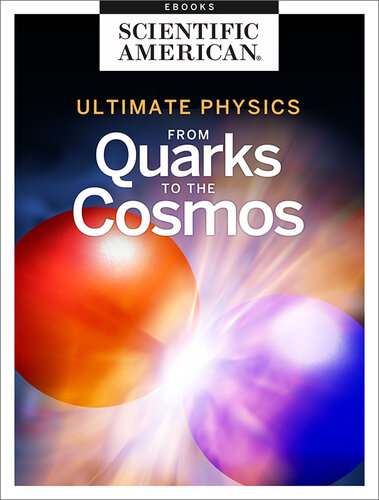Physics, in its vastness and intellectual rigor, serves as the foundational framework through which one comprehends the universe. The journey through physics spans from the infinitesimal particles known as quarks to the grand cosmic structures of galaxies, constituting a magnificent tapestry of scientific inquiry. This exploration not only elucidates the mechanisms governing the microcosm but also elucidates the phenomena of the cosmos. Each element of this scientific narrative warrants an exploration of its significance and relevance.
Quarks, the fundamental constituents of protons and neutrons, epitomize the starting point of this journey. They are elementary particles that engage in strong interactions via the exchange of gluons, which are mediator particles responsible for the strong nuclear force. The Standard Model of particle physics articulates this interplay, boasting an intricate framework that describes electromagnetic, weak, and strong forces. Fundamental discoveries such as color charge and confinement have advanced the comprehension of quark dynamics, leading to profound implications for the understanding of matter at its most elementary levels.
As we ascend from quarks to protons and neutrons, the story unfolds to encapsulate nuclear physics. Nuclear forces bind quarks together to form nucleons, and subsequently, nucleons unite to construct atomic nuclei. The balance of strong and weak forces within these nuclei yields insights into stability and radioactivity. An exploration into nuclear decay processes, such as alpha and beta decay, reveals the inherent instability in certain isotopes, propelling discussions on energy generation, particularly in nuclear reactors and stellar phenomena.
The transition from atomic interactions to the macroscopic realm introduces us to the tapestry of chemistry. Atoms, composed of electrons, protons, and neutrons, engage in intricate bonding mechanisms. The quantization of energy levels in atomic systems leads to the emergence of a plethora of chemical reactions, further diversifying the composition of matter. Understanding atomic structure and periodic trends not only nurtures the foundations of chemistry but also informs material science, enabling the development of novel materials with tailored properties.
Expanding the lens to encompass classical mechanics, we encounter a critical branch of physics that examines the motion of objects under the influence of forces. Newton’s laws of motion serve as the bedrock of classical mechanics, providing a systematic approach to understanding dynamic systems. From celestial bodies navigating the vastness of space to terrestrial objects influencing our daily lives, classical mechanics imparts crucial knowledge on inertia, momentum, and energy conservation. The applications of these principles ripple through various domains, including engineering and astrophysics.
Moreover, the beauty of classical mechanics intertwines seamlessly with the narrative of thermodynamics. The study of heat and energy transformations offers vital implications across both natural and engineered systems. Through the lens of the laws of thermodynamics, one can discern the principles that govern energy conservation, entropy, and equilibrium. These concepts not only underpin the operation of heat engines and refrigerators but also delineate the fundamental constraints of energy conversion processes across various physical systems.
Venturing further into the realm of electromagnetism unveils another pillar of physics that governs an extensive spectrum of phenomena. The electromagnetic force is responsible for the interactions between charged particles and is described comprehensively by Maxwell’s equations. The implications of these principles resonate in everyday technologies, including electric circuits, motors, and communication systems. An understanding of electromagnetic waves serves as a precursor to explorations in optics, radio waves, and even quantum mechanics.
The advent of modern physics ushers in the realms of special relativity and general relativity, challenging classical intuitions and broadening the understanding of time and space. Special relativity, introduced by Einstein, revolutionized the notions of simultaneity and relative motion, illustrating that time and space are interwoven into a four-dimensional continuum. This conceptual shift profoundly influences contemporary physics, particularly in the realms of high-energy particle interactions and the behavior of objects approaching the speed of light.
General relativity further escalates this discourse by addressing gravitational phenomena. The profound idea that mass warps spacetime has cultivated our comprehension of celestial mechanics. From the orbits of planets to the dynamics of black holes, general relativity elucidates the multifaceted relationships between mass, energy, and the curvature of spacetime. The detection of gravitational waves exemplifies the empirical affirmation of these theories and ignites discussions about the universe’s evolution.
Finally, as the narrative traverses from the infinitesimal to the cosmic, the exploration culminates in an examination of cosmology. This field contemplates the universe’s origin, evolution, and ultimate fate, employing observational astronomy to uncover the mysteries of galaxies, dark matter, and dark energy. The Big Bang theory offers a compelling explanation for the universe’s inception, leading to inquiries about cosmic inflation and the emergent structure formation. The vastness of the cosmos invites humans to ponder their place within it, raising philosophical questions about existence, time, and the nature of reality.
In conclusion, the journey through physics encapsulates an awe-inspiring narrative that begins with the subatomic world of quarks and transcends to the expansive cosmos. Each domain of physics not only contributes uniquely to our understanding of nature but also interconnects to form a cohesive framework. This intricate interplay navigates the marvels of the universe, engendering curiosity and fostering an insatiable quest for knowledge. As science continues to advance, the quest from quarks to the cosmos remains a fundamental pursuit of human understanding.












